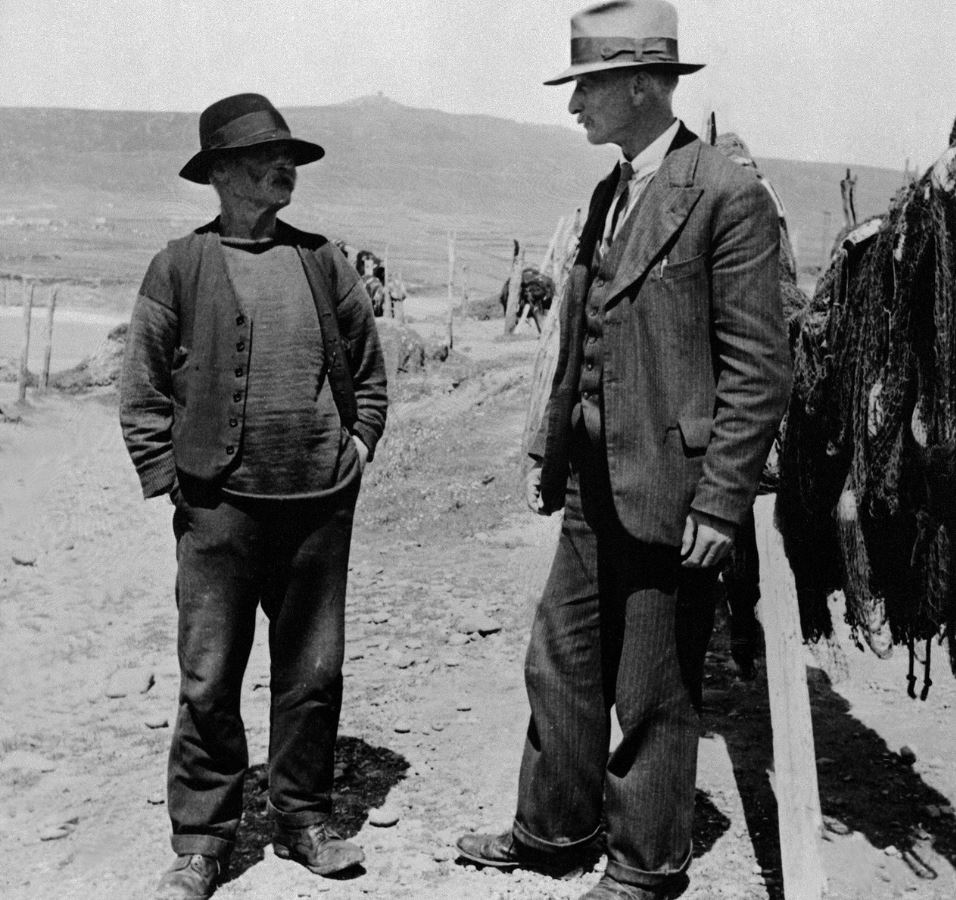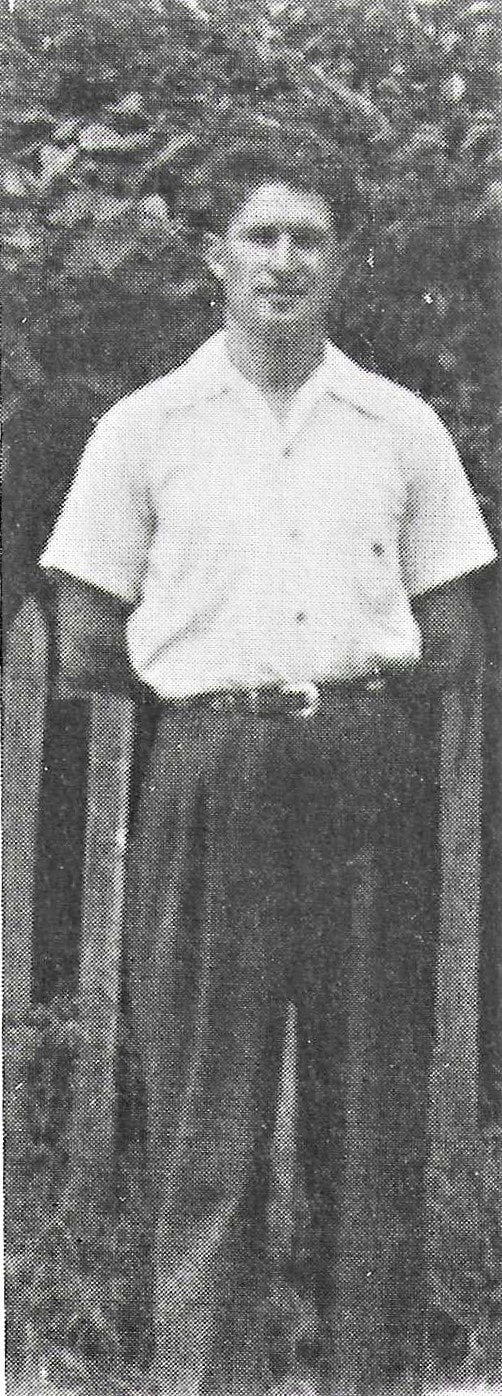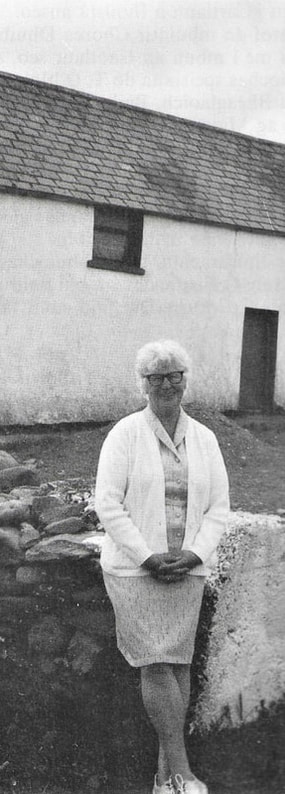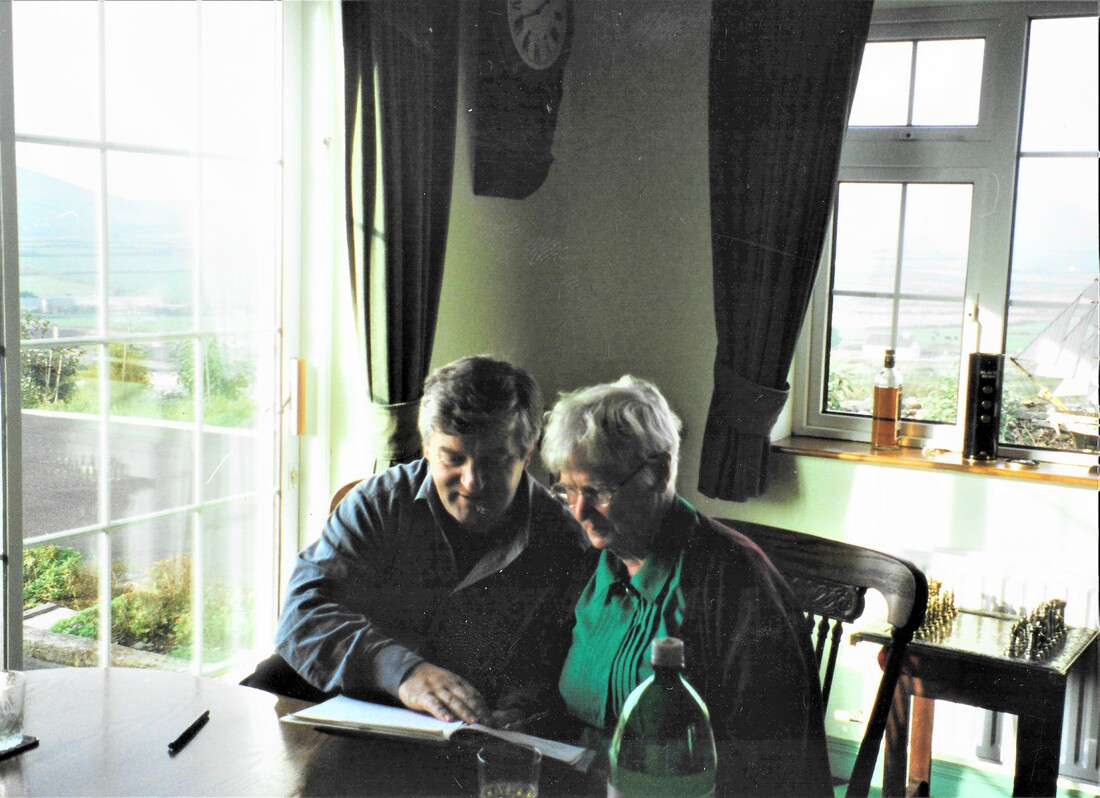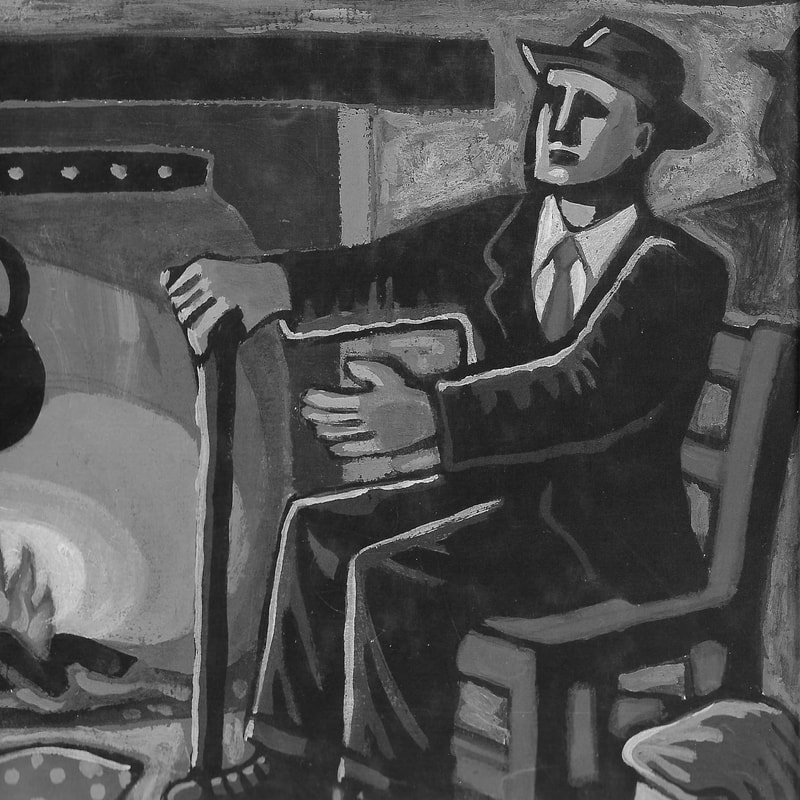1. Padraig Ó Grifín
|
Family Background:
Padraig Ó Grifín (1856-1936), son of Maurice (a farmer) and Johanna of Ballyroe (Baile Reo) north west of Dingle, Co. Kerry, married Catherine (Cait) Sheehy in Ballyferriter RC Church on 2nd February 1887. Cait was the daughter of Lawrence Sheehy from the adjacent townland of Graffee (Na Grafaí). Padraig and Cait lived in Ballyroe and they had 8 children of whom 6 were surviving in April 1911. One of their children, Mary Griffin (1895-1973), married Charlie Flannery (1895-1967), a Dingle fisherman, in Ballyferriter RC church on 17th of April 1917 with witnesses John Guiheen and Margaret Quirke. Mary and Charlie’s daughter, Margaret - my mother - married Johnny Piggott of Dooks, near Glenbeigh, Co. Kerry. Storytelling: Padraig was the local seanchaí for Baile Reo and the surrounding district of Baile na bPoc and Na Grafi (Graffee) and he was following in both his father’s and grandfather’s footsteps, as they were also storytellers who originally came from Connacht. His stories were collected by three people. Padraig’s daughter Bridget Griffin (1889-1961) married James Sullivan (1875-1962), a fisherman from nearby Ballyganeen, in Ballyferriter church on 16th February 1909. They had thirteen children: Patrick, John, Michael, Thomas, Maurice, Kathleen, Martin, James, Lawrence, Eamon, Breda, Mary and Brendan. Between 1932-1935, Kathleen, born in 1918, took down 15 stories from her grandfather Padraig in copybooks which are now housed in the Irish Folklore Commission premises in Dublin. She married Flurrie O’Donoghue from Baile na Buaile where I spent many days visiting her, listening to her accounts of how she collected the stories from her grandfather, before she passed away at the age of 96 in 2015. Kathleen’s brother Martin born in 1921, took down 35 stories from Padraig which are also in the Irish Folklore Commission in Dublin. Martin immigrated to Boston in 1946 and, although I never met him in person, we did speak by telephone on a number of occasions before he passed away in 2012 at the age of 91. The third and main collector of Padraig Ó Grifín’s stories was Sean Ó Dubhda (John O’Dowd), a primary school teacher who collected stories from seanchaí throughout Kerry for the Folklore of Ireland Society. This Society was established in 1927 to save the folklore of Ireland and was the forerunner of the Irish Folklore Commission which was established in 1935. Ó Dubhda was born in Co. Clare in 1878 and came to Kerry after completing his teacher training in Dublin and he reported: “Patrick Griffin told the stories exactly as he heard them to the extent you would think he was reading from a book. He would continue telling them, not only throughout the night but throughout the day as well if he was allowed to”. Kathleen remembers Sean Ó Dubhda coming to her family home to listen to her grandfather and his director, Séamus Ó Duilearga, often accompanied him on these occasions. Sean always travelled by bike and he brought a quarter of tobacco for Padraig. He collected over 40 stories from Padraig between 1930 -1935, most were recorded on wax cylinders with his Edison Ediphone recorder. Although very few of these original sound recordings have survived, as the cylinders were re-waxed for further recordings after the stories were taken down on paper (the Society funding was very scarce), I was very lucky to find a brief 2-minute voice recording of Padraig Ó Grifín, made by Ó Dubhda in 1932, in the recording archives of the Irish Folklore Commission, who kindly presented me with an mp3 copy of his voice recording which I cherish! In 1992, Áine-Máire Ní Fhaoláin completed an MA-Thesis in the University of Maynooth on the collected stories of Padraig Ó Grifín which was subsequently published in book format by An Sagart An Daingean in 1995 entitled “Scéalta agus Seanchas Phádraig Uí Ghrífín”. The book, containing over 80 stories, is a wonderful testament to the life and storytelling tradition of the seanchaí Padraig Ó Grifín. Recording of Padraig Ó Grifín and photo of Sean Dubhda provided courtesy of Irish Folklore Commision, Dublin Ireland
|
Stories of Padraig Ó Grifín
|
AN PÍOBAIRE SAN LIOS
Bhí píobaire ag teacht abhaile ó chomhthalán rince oíche. Chuala sé ceol breá bog istigh i lios, nuair a bhí sé ag gabháil thairis. Stad sé ar feadh tamaill ag éisteacht leis an gceol. Nuair a bhí an ceol thart, thosnaigh an píobaire ag seinm. Nuair a chualaigh dhream an leasa an ceol amuigh seo leo amach. Thugadar leo isteach an píobaire bocht. Chuireadar isteach i seomra é. Bhí seanduine ansan istigh rompu. Dúradar leis an seanduine a shúile a choimeád ar an bpíobaire go dtiocfaidís féin aris. Nuair a bhíodar imithe, arsan píobaire leis an seanduine: "Cé hi an bhean san ar do chúl?" D'fhéach an seanduine ar a chúl, ach ni túisce a d'fhéach ná bhí an piobaire bailithe leis. Nuair a tháinig sé abhaile, chonaic sé duine cosúil leis fein istigh i leaba, é an-dhreoite. Chuimhnigh sé laithreach gur duine ón lios a bhí ann. Chuaigh sé amach arís agus thug sé isteach seanshluasaid. Chuir sé an tsluasaid isteach san tine. Nuair a bhí sí dearg thóg sé amach í agus chuaigh sall go dtí an leaba. Nuair a chonaic fear na leapa an tsluasaid dhearg ag teacht chuige, siúd amach tríd an bhfuinneoig é, deirimse leat ná raibh na dathacha ina chosa. Níor chuaigh an píobaire in aon [ghJiorracht don lios riamh ó shin. |
THE PIPER IN THE FAIRYFORT
There was a piper coming from an assembly of a night dancing. He heard lovely soft music coming from the Fairyfort (Lios) on his passing. He stopped for a while to listen to the music. When the music finished, the piper started playing. When the people from the Fairyfort heard the music out they went. They brought in the poor piper. They put him into a room. There was an old person in there before them. They told the old person to keep an eye on the piper until they arrived back again. When they were gone the piper said to the old person " who is the old woman at your back". The old person looked around and he no sooner had that done when the piper took off. When he arrived home, he seen somebody very like himself in a bed, he looked decayed (é an-dhreoite). He thought for sure it was a person from the Fairyfort. He went out then and brought in an old shovel. He put the old shovel into the fire. When it had turned red with the heat he took it out and went over to the bed. When the man in the bed seen the red shovel coming his way, out with him through the window, and I'm telling you the smoke was not coming from his legs. The piper never went anywhere near the Fairyfort since. |
|
MUINTIR GHRÍFÍN
Ó Chúige Chonnacht a tháinig muintir Ghrífín go Paróiste Múrach fadó. Sin nuair a bhí an drochaimsir ann agus an ruagairt orthu is iad ag imeacht ó áit go háit. Do bhuaileadar fúthu i bParóiste Múrach agus nuair a leathanaíodar is go rabhadar thall is abhus ann agus táid siad riamh ó shin ann ó thángadar ó Chúige Chonnacht. Fir mhaithe chrua láidre ab ea iad. Sean-Phaidí an Chonnaigh (toise gur ó Chonnachtaibh iad tugadh Connaigh orthu) ab ea m'athair críonna. Deirtear gur chuaigh sé go Barra Chnoc Bréanainn lá Easpag Morartí - Lá Shain Seáin Beag 1868. Bhí Sean-Phaidí 84 bliaina san am san is do mhair sé i bhfad ina dhiaidh san go raibh sé go hard os cionn céad. Tugtaí Mantach an Chonnaigh leis air toisc gan aon fhiacail a bheith aige. Deir daoine ná raibh fiacla riamh aige. Chognódh sé císte arán buí ón ngrideall chomh maith le haon fhear go raibh cíor aige. Bhí drandal go cruaidh aige. |
THE GRIFFIN CLAN
From the Provence of Connacht the Grifin family came to the parish of the Moors long ago. That's when bad times were in the area as they were traveling from place to place. They settled down in the parish of the Moors* and spread out so that they were everywhere and have been there since they arrived from the Provence of Connacht. Seán-Pháidí Quinn (because they came from the Provence of Connacht the Quinn name was given to them) was my grandfather. It's said he went to the top of Mount Brandon, day of the bishop Morartí ( Lá Shain Seáin beag 1868) the shortest day of the year 1868. Seán-Pháidí was 84 years old at that time and lived well past it until he was over 100 years. He was called Mantach (an old sheep with no teeth). People say he never had teeth. He would chew yellow cake bread from the griddle as well as any man was able. He had hard Gums (Drandal). * The townland of Moors or Moorestown (Baile an Mhúraigh) in the parish of Kilquane (Cill Chuáin), Dingle. The name probably derives from Richardus Moore de Kilcullye (Kilcooly) who resided there in the 1660s. Baile Reo lies within the parish of Kilquane. |

